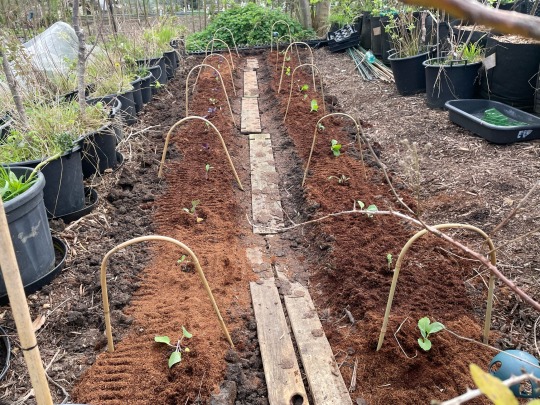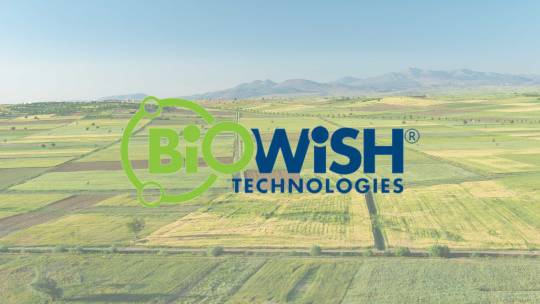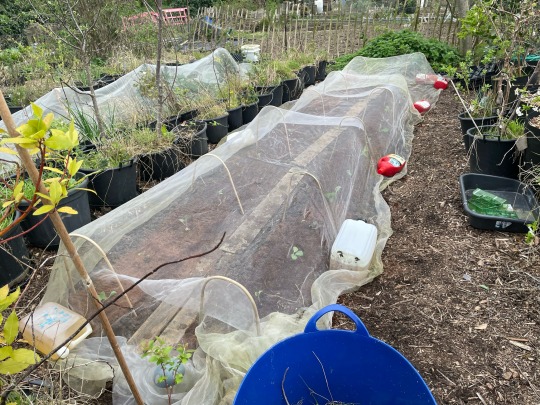#crop protection
Text

Spring in the garden


I need to net over due to the pigeons about.
#growing fruit and veg#sylvanthorn#gardening adventures#2024#cabbages#purple sprouting broccoli#crop protection#pigeon menace
2 notes
·
View notes
Text
Vegetable Garden Update March
On the list for this month of gardening stuff I need to do is to plant my broad beans, garlic, and poppies outside. They benefit from the cold.
Next it is time to start a bunch of seeds inside to set out for April after the last frost. That will be the lettuce, pac choi, and peas. I also need to start the potatoes. I have the seed potatoes, felt grow pots, and bone meal. It is just waiting on me to pick up some more potting soil. That needs to get done after our last frost around the 22nd. I could do it sooner but would then need to be on top of watching for frost.
Once those have been started I can look at getting my tender hot season crops started. I have several varieties of tomatoes and melons for this year.
#garden row cover#frost protection#gardening#plastic row cover#vegetable gardening#crop protection#the busy season in gardening is about to start for me
3 notes
·
View notes
Text
#agriculture#agtech#agritech#farming#technology#agriculture technology#digital farming#crop protection#remote sensing#pest control
1 note
·
View note
Text

Shriram Farm Solutions: Empowering Indian Agriculture with Science-Backed Solutions
Shriram Farm Solutions - Your one-stop shop for success in Indian agriculture. We offer high-quality seeds, crop protection, fertilizers, and expert advice to help you achieve sustainable, bountiful harvests.
To know more, visit: https://shriramfarmsolutions.com/
1 note
·
View note
Text
Nematicides Market by Type (Chemical {Organophosphate, Carbamate, Fumigant}, Biological {Microbial [Bacillus Species]}, Biochemical), Form, Nematode Type (Root-knot, Cyst Nematodes), Mode of Application (Seed Treatment), Crop Type - Global Forecast to 2030
#Nematicides Market#nematicides#crop protection#agrochemicals#agriculture#agribusiness#chemicals#chemical industry
1 note
·
View note
Text
BiOWiSH® Crop Liquid's Global Reach and Impact
Key Takeaways
Global Adoption: Over 5 million acres of farmland across multiple countries now benefit from BiOWiSH® Crop Liquid, thanks to strategic collaborations with leading agricultural companies.
Enhanced Crop Yields: Independent trials report an average yield increase of 7.7% across various crops, with an 86% win rate, underscoring the product’s efficacy.
Sustainable Farming: BiOWiSH® is…

View On WordPress
0 notes
Text
Ag-tech Start-Up WeedOUT Raises USD8.1 Million to Fight Weed Resistance
Ag-tech start-up WeedOUT, Ltd., announces it has secured USD 8.1 million in A-round funding. Leading the round is Fulcrum Global Capital, a prominent US agri- focused VC with ties to a vast network of farmers across the US. The infusion of new capital will advance the company’s mission to combat weed resistance through its breakthrough green solution.
WeedOUT Team 2024
Other participants in the…

View On WordPress
#Agricultural Innovation#Agricultural Tech - Farming Tech#Agriculture#AgTech#AgTech and FoodTech Funding#AgTech Startup#Biologicals in Farming#Crop Protection#Food and Agribusiness#Herbicides#Sustainable Agriculture
0 notes
Link
CPL's daily case study on tumblr.... CPL assessed the market for anti-insect netting in Europe, estimating the area for protected cultivation and losses to various pests.
#crop protection#glasshouses#strategy#management consulting#cplconsult#insect netting#market analysis
0 notes
Text
How Does Seed Treatment Help in Improving Yield?
Seed treatment can be defined as the application of insecticide, fungicide, or both to seeds to disinfect them from soil-borne or seed-borne pathogenic organisms or storage insects. It refers to seeds subjected to immersion in conditioned water, solar energy exposure, or others.
The seed treatment helps in preventing the spread of plant diseases. It protects seeds from seedling blights and seed rot. In addition, seed treatment improves germination, ensures protection from storage insects, and controls soil insects.

Methods for Seed Treatment
Seed Dressing: Seed dressing is the most common method for seed protection. In this way, the seed is dressed with either a dry formulation or wet treatment with a liquid formulation or slurry. Dressings need to be applied in both industries, and farms. This process involves, spreading the sheet on a polyethylene sheet, and needs several chemicals for sprinkling on surface seeds.
Seed Coating: The seed coating method is primarily utilized in industries. It involves advanced treatment technology.
Seed Pelleting: It is a method utilized for transforming the physical shape of the seed to improve palatability. This process involves sophisticated seed treatment technology.
The seed treatment industry is projected to rise in the coming years. It is ascribed to surging government initiatives, and efforts of private organizations to enhance the crop yield, with increasing application of technologically advanced seed treatment solutions for improving the seed quality, and growing requirement for basic grains and vegetables, led by increasing population.
Under the crop type, cereals and grains capture the largest industry share, in terms of both value, and volume. It is ascribed to the massive-volume production of cereals and grains, including wheat, rice, corn, ragi, barley, and sorghum, led by increasing consumption and surging per capita income.
Under the application method segment, the dressing category holds the largest volume and revenue shares. It is ascribed to the rising usage of dressings as dry formulations, wet-treated slurry, and liquid formulation applications.
Under the application time segment, the pre-treatment category captures the largest industry share, in terms of both revenue and volume. It is ascribed to the rising adoption by the manufacturer for the protection of seeds from soil-borne, and seed-borne diseases.
APAC captures the largest industry share, and it is projected to follow the same trend in the coming future. It is ascribed to the high-volume crop production in countries, such as Vietnam, South Korea, India, China, and Australia. Furthermore, these countries employ more seed protection products to improve yield.
#seed treatment#agriculture industry#market analysis#seed treatment technology#agricultural innovations#market trends#crop protection#seed coating#pest control#agricultural advancements#market dynamics#seed treatment solutions#sustainable agriculture#crop enhancement#seed treatment market outlook
0 notes
Text

Spring in the garden

Not easy to net up on a windy day. I have some mulching to do but that’s for another day.
1 note
·
View note
Text
Seed Treatment Market: Enhancing Crop Yield and Protection
If it is said that the entire agriculture is dependent on seeds, then surely it is right. They are the point of initiation of a crop lifecycle, and if the seeds don’t germinate, crops fail.
There are a lot of challenges faced by seeds, such as pests to diseases and also environmental conditions. It is a fact that seeds can come on top of all these challenges by themselves, the probabilities for…

View On WordPress
#agriculture#Bio-based Solutions#Crop Productivity#Crop Protection#crop yield#Disease Management#Global Food Security#innovations#market trends#Modern Agriculture#pest control#Seed Treatment Market#Seed Treatments#Sustainable Farming
0 notes
Text
Mitra Airotec Turbo 2000liter
🔰Uniform coverage
🔰Best crop protection
🔰Precision spraying
🔰Labour, Chemical & Time saving
🔰Works on 45 HP & Above tractors
visit our website for more details : www.mitrasprayer.com
Call on : +91-7722002144
+91- 9096668103
Email id : [email protected]
[email protected]
Facebook:- https://lnkd.in/en5x-iYJ
Instagram:- https://lnkd.in/ejRyb8tJ
Youtube:- https://lnkd.in/diTurRqc
#mitrasprayer#no1sprayers#orchardsprayer#worldfarming#agricultureandfarming#farming#horticulture#vineyard#agriculture#cropprotection#pesticidesaving#fungicide#protector#airblaster#airassisted#precisionfarming#precisionagriculture#precisionspraying#finedroplet
#agriculture#farming#horticulture#mitrasprayer#orchard crops#vineyard#crop protection#worldfarming#precision spraying#airassisted#airblast
0 notes
Text
Weed Control Market - Forecast (2023 - 2028)
View More @ https://tinyurl.com/57p9bp26
As per the report by The National Center for Biotechnology Information (NCBI), the global human population is anticipated to increase to 9 billion by 2050, which in turn will increase the demand for food consumption by 50%. The main objective of the government and associated organizations is to increase the agriculture yield without increasing the global agricultural land and also without adverse environmental impacts. This process can only be achieved with weed management strategies and continuous innovations in the field. The emerging global challenges such as climate change, food security, environmental degradation, the evolution of resistance to herbicides, and escalating rates of plant invasion are influencing the weed control market. Moreover, NCBI suggested that weed problems are only going to rise in the coming years and will be becoming more inflexible barrier in efforts towards the sustainable intensification.[1] These challenges provide the opportunities for adoption of weed control which had a market size of $28.2 billion as of 2018. Furthermore, the demand for weed control will witness a compound annual growth rate (CAGR) of 3.5% during the forecast period of 2019 to 2025.
#weed control market#weed control market size#weed control market shape#weed control market forecast#weed control market analysis#weed control market report#weed control market research#weed control market price#weed control market share#weed control#chemical herbicides#crop protection#crops
0 notes
Text

Explore Kheti Buddy, the most powerful farm data management app. Simplify farming tasks, monitor progress, and make informed decisions effortlessly.
0 notes
Text

Agrochemicals have played a crucial role in modern agriculture, significantly transforming the way we produce food. Read More: https://cmibloggers.blogspot.com/2023/06/the-impact-of-agrochemicals-on-crop.html
#Coherent Market Insights#Chemical and Materials Industry#Agrochemicals#global agrochemicals market#Pesticides#Fertilizers#Crop protection#Soil health#Pest management
0 notes
Text
What is Agritech?
Reports state that the “global Agritech market was valued at US$ 17,442.7 million in 2019 and is projected to reach US$ 41,172.5 million by 2027; it is expected to grow at a CAGR of 12.1% from 2020 to 2027.”
By definition, agritech involves using technology and technological innovation to enhance the efficiency and output of agricultural processes. The extensive agritech applications encompass different types of agricultural and technological innovations that aim to grow more food in less space and/or with fewer inputs. Since tasks are automated, it replaces much of the labour needed in a farming operation, which saves farmers’ time and money.
In this blog, we have discussed
· Advantages and disadvantages of agritech, and
· Ways to create farmer engagement in agritech
Advantages of Agritech
1. Modern-day farmers and home gardeners are showing a considerable amount of interest in organic farming and growing their food. For organic fertilisers, heirloom seeds, preparing compost and mulch are done with the help of agritech.
2. With integrated farming gaining popularity, farmers are exploring honeybee and silkworm rearing, fish culture, and more so that they don’t have to depend on a single occupation for income. Combining technology with agriculture helps farmers explore more activities.
3. Technological advancements allow people to start soilless agriculture known as hydroponics and use nutrient solutions instead of soil to grow crops.
4. Agritech enhances farm efficiency; hence, farmers can grow several crops on limited land. Each acre of land gets an adequate amount of seeds, fertilisers, and a timely water supply ensures optimum yield.
Disadvantages of Agritech
1. The agritech industry requires immense research and development which is the biggest setback. To implement technological reforms, proper experiments need to be conducted so that nothing is at stake.
2. Another drawback of agritech is that it requires capital. To accommodate machines, and computers, and educate the farmers to use these technologies, a considerable amount of money is required. The biggest challenge of agritech industry is the lack of knowledge.
Ways to Create Farmer Engagement in Agritech
Farmers’ engagement in Agritech helps enhance productivity and yields and allows farmers and buyers to facilitate trades using mobile applications. The emergence of agritech platforms is revolutionising the agricultural ecology and helps maintain transparency.
1. For farmer engagement, a well-designed onboarding experience is essential. You can stay connected with your customers and increase conversion rates at the early stages of the app’s engagement. Make sure your application is easy-to-use as it will allow farmers to understand your app better.
2. Providing personalised services will allow farmers to consume more products, purchase them, and engage with agritech apps. Personalisation has better engagement compared to standardisation. Farmers usually rely on human interactions to get their queries resolved as they have a personal relationship with their farms. They are passionate about their profession and are willing to spend money on the tools needed to grow food. Hence, they appreciate personalised content customised based on location and language.
3. Another great means to keep users engaged are push notifications. They provide farmers with more information about what is happening, remind them about events, and notify them about new data. Having a customised strategy helps engage farmers who are crucial to agritech’s digital transformation.
4. Social media allows an instantaneous flow of information from one person to another and offers an open platform where farmers and agritech professionals can share their knowledge and experiences. With the help of social media, agritech platforms can create a one-stop destination for niche agricultural communities to get trustworthy suggestions from industry experts. Farmers get access to information on the latest agricultural practices, modern-day farming techniques, and upcoming agricultural events.
Wrapping Up,
For more information on agritech and farmer engagement, browse the KG2 official website, Australia’s leading independent farmers’ database or get in touch with our experts for a personalised understanding of agritech.
#agriculture#agribusiness#regenerative agriculture#iot in agriculture#lead generation#farming#organic farming#organic fertiliser#crop protection
1 note
·
View note